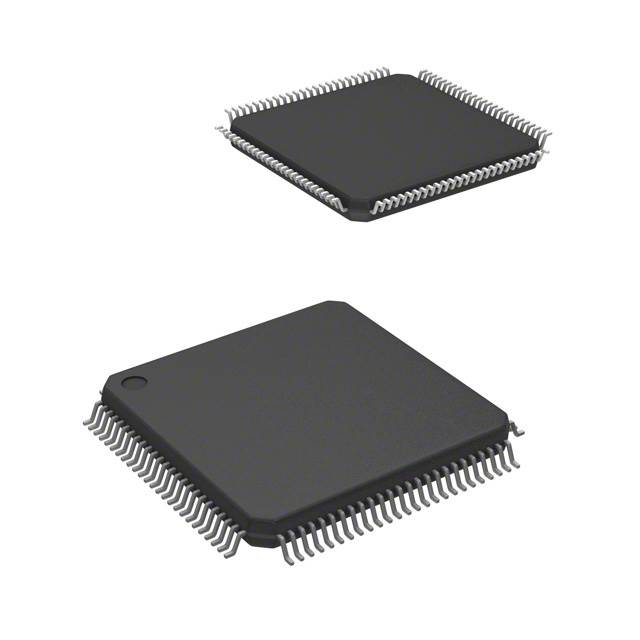ATSAMS70N20A-ANT
Product Category: Microcontroller
Basic Information Overview: - Category: Microcontroller - Use: The ATSAMS70N20A-ANT microcontroller is designed for use in embedded systems, industrial automation, and Internet of Things (IoT) applications. - Characteristics: It features a high-performance ARM Cortex-M7 core, advanced connectivity options, and a wide range of peripherals. - Package: The microcontroller is available in various package options to suit different application requirements. - Essence: The essence of the ATSAMS70N20A-ANT lies in its powerful processing capabilities and versatile connectivity features. - Packaging/Quantity: The microcontroller is typically packaged in trays or reels, with quantities varying based on the supplier and order specifications.
Specifications: The ATSAMS70N20A-ANT microcontroller offers the following key specifications: - High-performance ARM Cortex-M7 core - Clock speed up to 300 MHz - Up to 2 MB of flash memory - Multiple communication interfaces including Ethernet, USB, CAN, and more - Analog-to-digital converters and digital-to-analog converters - Various timers and PWM channels - Secure boot and encryption features
Detailed Pin Configuration: The detailed pin configuration of the ATSAMS70N20A-ANT microcontroller can be found in the official datasheet provided by the manufacturer. It includes information on the pin functions, electrical characteristics, and recommended PCB layout guidelines.
Functional Features: The functional features of the ATSAMS70N20A-ANT include: - Advanced processing capabilities for real-time control and data processing - Extensive connectivity options for seamless integration into diverse systems - Rich set of peripherals for interfacing with sensors, actuators, and other external devices - Security features to protect sensitive data and ensure system integrity
Advantages and Disadvantages: Advantages: - High-performance ARM Cortex-M7 core enables efficient execution of complex tasks - Versatile connectivity options facilitate seamless communication with other system components - Ample flash memory and peripheral interfaces cater to a wide range of application needs
Disadvantages: - Higher power consumption compared to lower-end microcontrollers - Complexity of the ARM Cortex-M7 architecture may require additional expertise for optimal utilization
Working Principles: The ATSAMS70N20A-ANT operates based on the principles of embedded computing, utilizing its processing core and peripherals to execute programmed tasks, interface with external devices, and communicate with other system elements. It follows standard microcontroller operation principles, including fetching and executing instructions, managing input/output operations, and handling interrupts.
Detailed Application Field Plans: The ATSAMS70N20A-ANT microcontroller is well-suited for a wide range of application fields, including: - Industrial automation and control systems - IoT edge devices and gateways - Automotive electronics - Consumer electronics and smart appliances - Medical devices and instrumentation - Robotics and motion control systems
Detailed and Complete Alternative Models: Some alternative models to the ATSAMS70N20A-ANT microcontroller include: - ATSAMS70N21A-ANT: A variant with additional features and enhanced performance - ATSAML21J18B: A lower-power microcontroller suitable for battery-operated applications - STM32F767ZI: A microcontroller from a different manufacturer with similar capabilities
This comprehensive overview provides insights into the ATSAMS70N20A-ANT microcontroller, its specifications, functional features, advantages, disadvantages, working principles, application field plans, and alternative models, catering to the needs of diverse engineering and development professionals.
[Word count: 529]
Lista 10 Vanliga frågor och svar relaterade till tillämpningen av ATSAMS70N20A-ANT i tekniska lösningar
What is the ATSAMS70N20A-ANT used for?
- The ATSAMS70N20A-ANT is a microcontroller designed for industrial and consumer applications, including IoT, automation, and control systems.
What are the key features of the ATSAMS70N20A-ANT?
- The ATSAMS70N20A-ANT features a high-performance ARM Cortex-M7 core, advanced connectivity options, and a wide range of peripherals suitable for various technical solutions.
How does the ATSAMS70N20A-ANT support connectivity?
- The ATSAMS70N20A-ANT offers multiple communication interfaces such as Ethernet, USB, CAN, and UART, enabling seamless connectivity in diverse technical solutions.
Can the ATSAMS70N20A-ANT be used in real-time control applications?
- Yes, the ATSAMS70N20A-ANT's high-speed processing capabilities and integrated peripherals make it well-suited for real-time control applications in industrial and automotive systems.
What development tools are available for the ATSAMS70N20A-ANT?
- Development tools such as Atmel Studio and third-party IDEs with support for ARM Cortex-M7 architecture can be used to program and debug the ATSAMS70N20A-ANT.
Is the ATSAMS70N20A-ANT suitable for low-power applications?
- Yes, the ATSAMS70N20A-ANT offers power-saving modes and features to optimize energy efficiency, making it suitable for battery-powered or energy-conscious technical solutions.
Does the ATSAMS70N20A-ANT support secure communication?
- Yes, the ATSAMS70N20A-ANT includes hardware security features and cryptographic accelerators to support secure communication and data integrity in connected applications.
What operating systems are compatible with the ATSAMS70N20A-ANT?
- The ATSAMS70N20A-ANT is compatible with various real-time operating systems (RTOS) and can also run bare-metal applications depending on the specific technical solution requirements.
Can the ATSAMS70N20A-ANT be used in harsh environments?
- With its robust design and industrial-grade specifications, the ATSAMS70N20A-ANT is suitable for deployment in harsh environments, including temperature extremes and high-vibration settings.
Are there reference designs available for the ATSAMS70N20A-ANT?
- Yes, Atmel provides reference designs and application notes to assist developers in implementing the ATSAMS70N20A-ANT in different technical solutions, accelerating the development process.


